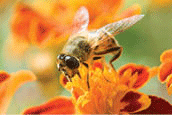
The more science learns about plants, the more we are amazed at what we see designed into them. One of those things is the use of smell. We may not have thought about it too much, but smell depends upon chemicals. When you smell something, whether it is pleasant  or noxious, it is actually chemicals in the air secreted by the plant or animal that you are detecting. The way plants use chemicals and the sense of smell is incredible.
or noxious, it is actually chemicals in the air secreted by the plant or animal that you are detecting. The way plants use chemicals and the sense of smell is incredible.
Humans have used perfumes as attractants for a long time, and plants do that as well. Smell is more efficient than color for attracting bees, wasps, flies, butterflies, beetles, moths, birds, bats, and even mice. A plant has a fragrance because that smell attracts pollinators that allow the plant to fertilize and produce seeds. Each plant has a different chemical compound it uses as its attractant. In some cases only one kind of insect or moth is attracted to that chemical, so the smell becomes very specific as to what the pollinator will be.
Another plant smell that is rather incredible is the smell that is used as what researchers call “negative communicators.” A good example is  the lima bean. Lima bean plants are attacked by spider mites. Spider mites are eaten by carnivorous mites. When the lima bean is attacked by spider mites, it floods the area with a chemical signal which attracts the carnivorous mites and causes other lima bean plants to emit the same chemical. When the spider mites have all been eaten, the plant ceases secreting the chemical. Squash plants have a similar system.
the lima bean. Lima bean plants are attacked by spider mites. Spider mites are eaten by carnivorous mites. When the lima bean is attacked by spider mites, it floods the area with a chemical signal which attracts the carnivorous mites and causes other lima bean plants to emit the same chemical. When the spider mites have all been eaten, the plant ceases secreting the chemical. Squash plants have a similar system.
As we work towards being able to feed the human population on this planet, we have to be aware of the special properties of plants, and the design and intelligence that is built into these living systems. Truly we can “know there is a God through the things he has made.” (Romans 1:20). Source: National Geographic, February 2004.
Picture credits:
© PH.OK. Image from BigStockPhoto.com
© Sofiaworld. Image from BigStockPhoto.com
